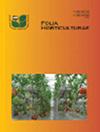The use of stinging nettle tea (Urtica sp.) to control Aulacorthum solani and Macrosiphum euphorbiae on Ranunculus asiaticus
IF 1.8
4区 农林科学
Q2 HORTICULTURE
引用次数: 1
Abstract
ABSTRACT Natural and environmental-friendly approaches to control pests and diseases in horticultural production systems are showing an increasing trend. Biological alternatives, such as botanical extracts and basic substances, show promise in the reduction of the necessity for conventional plant protectants. In ornamentals, less is known about the usage, behaviour and potential of botanicals and basic substances for plant protection. In two trials, we investigated the effect of a weekly foliar spray of an aqueous extract of nettle (Urtica sp.; dried material 15 g · L–1) on two aphids, Macrosiphum euphorbiae and Aulacorthum solani. Experiments were conducted in the greenhouse with Ranunculus asiaticus as hostplant. The Urtica tea and azadirachtin (NeemAzal-T/S) as a standard used in common horticultural production were compared with the water control. Both previously infested and noninfested plants were built up to examine the effect on aphid population growth and migration. As a result, we showed that both treatments, Urtica tea and azadirachtin, reduce the aphid density significantly in comparison with the water control, although the effect of the Urtica tea was not as substantial as that of azadirachtin. Contrarily, treatments could not prevent aphid migration on previously noninfested plants. The study demonstrates that the basic substance Urtica tea can be suitable for the reduction of aphid pests in ornamental plant production, and thus, reduce the amount of synthetic plant protectants in horticulture.刺荨麻茶防治亚洲毛茛上的茄蚜和大戟蚜
在园艺生产系统中,采用自然和环境友好的方法控制病虫害正呈现出日益增长的趋势。生物替代品,如植物提取物和基本物质,有望减少对传统植物保护剂的需求。在观赏植物方面,人们对植物药和植物保护基本物质的使用、行为和潜力知之甚少。在两项试验中,我们研究了每周在叶面喷洒荨麻(Urtica sp.;干料15 g·L-1)对两种蚜虫,大蓬蚜和茄蚜。以亚洲毛茛为寄主植物,在温室内进行了试验。以乌蒂卡茶和印楝素(NeemAzal-T/S)作为普通园艺生产的标准,与水分控制进行了比较。建立了以前侵染和未侵染的植物,以研究对蚜虫种群生长和迁移的影响。结果表明,与水对照相比,荨麻茶和印楝素两种处理都显著降低了蚜虫密度,尽管荨麻茶的效果不如印楝素那么明显。相反,处理不能阻止蚜虫在以前未感染的植物上迁移。研究表明,荨麻茶基础物质可用于减少观赏植物生产中的蚜虫,从而减少园艺中合成植物保护剂的用量。
本文章由计算机程序翻译,如有差异,请以英文原文为准。
求助全文
约1分钟内获得全文
求助全文
来源期刊

Folia Horticulturae
Agricultural and Biological Sciences-Horticulture
CiteScore
3.40
自引率
0.00%
发文量
13
审稿时长
16 weeks
期刊介绍:
Folia Horticulturae is an international, scientific journal published in English. It covers a broad research spectrum of aspects related to horticultural science that are of interest to a wide scientific community and have an impact on progress in both basic and applied research carried out with the use of horticultural crops and their products. The journal’s aim is to disseminate recent findings and serve as a forum for presenting views as well as for discussing important problems and prospects of modern horticulture, particularly in relation to sustainable production of high yield and quality of horticultural products, including their impact on human health.
 求助内容:
求助内容: 应助结果提醒方式:
应助结果提醒方式:


